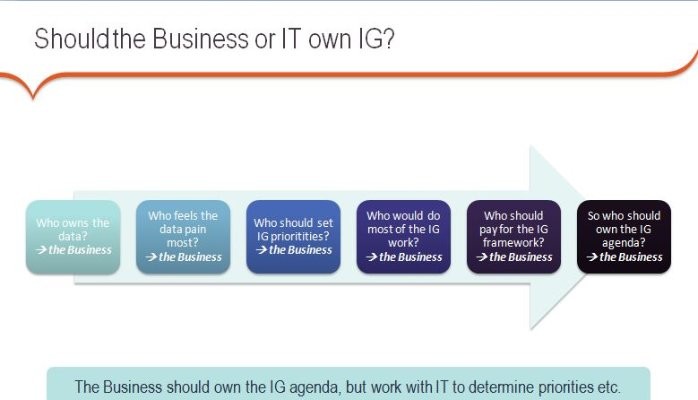
Who owns Information Governance? Business or IT?
Should the Business or IT decide the agenda and roadmap of your Information Governance (IG) program? It’s quite simple really: they should do it jointly. But it is the Business, not IT, that owns the data. It’s the Business that feels the pain most. It’s the Business that will end up doing the bulk of the IG work. So of course it’s the Business that should more strongly influence IG decisions (see diagram “Should Business or IT own IG?”). If they themselves don’t understand this or see it this way, then the answer is not to revert to IT, but to educate the Business.
And once new, Group-wide standards, definitions, processes, policies, data hierarchies etc. have been agreed they each need to get a single, executive owner, someone who is personally accountable and responsible to ensure the integrity of the new standard. And all standards should be hosted on a central Intranet or SharePoint portal for all staff members to access. This portal would show the standard, the owner and the change control process. This will inspire staff in the credibility of the standard and deter mavericks from changing the standard for their own (department’s) interests.
The IG program at a large UK retailer brought these ownership issues into sharp focus: IT saw the Business as insufficiently engaged on data issues, but the Business quickly understood that they must be fully involved to ensure the program delivers business value, not just better data quality.
[this is part 8 in a 14-part blog on Capgemini’s “QuickStart Information Governance” framework]
For more information on QuickStart Information Governance, please contact Ralf Teschner.
SAP MDG - EAM Consultant at Utopia Global, Inc.
9yGood one Ralf...!!
Partner at Everest Group | Apps & Engg services solutions and pricing analytics
9yHey Ralf, Great insights but do you think that forming a steering commitee with representatives from both IT and business can be a possible solution. Also the purpose of moving from CTO ( Chief Technology Officer) to a CIO ( Chied Information Officer) was to have a designate who understands technology and its impact on the business
Great piece Ralf, really enjoying this insightful blog series!!